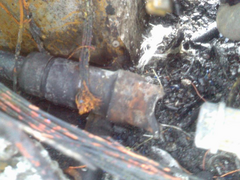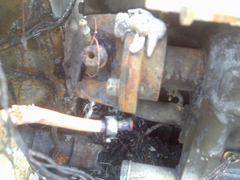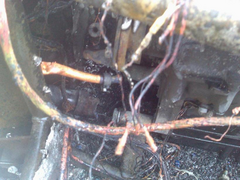So how then do the CEC's manage to use the small joints and run 180FtLb.

Use a decent prophaft supplier who uses new parts throughout the build of the shaft.
Cheers Matt

Hi Guys, I have a MNR with a Busa engine in that keeps snaping propshafts on the universal joints. I have taken the shaft back to Dunning &
Fairbank today who said that the propshafts are only rated to 160 Bhp Max (1100 series) and that I need a 1300 series propshaft to cope with the Busa
power (180 Bhp), the shaft would then be good for 350 Bhp. The problem is that the Universal joints will be bigger in diameter and I would need a
larger diameter bike sprocket adapter to connect to the 1300 series prop.
Is anyone else breaking props like we are and are there any other alternatives?
[Edited on 26/8/10 by cosworthspeed10]
[Edited on 26/8/10 by cosworthspeed10]
go CEC?
Have a word with GB Engineering - they custom make driveshafts etc to your spec and they might be able to suggest something.
i would be worried about them giving you specs in BHP as BHP does not break things torque (the twisting force) does the damage
You may have a problem caused by the flanges that the ends of the shaft connect to not being parallel to each other.
quote:
Originally posted by tomgregory2000
i would be worried about them giving you specs in BHP as BHP does not break things torque (the twisting force) does the damage
It still makes more sense to spec shafts for torque as power has sod all to do with it. I see this all the time, with things like performance clutches specified for power figures rather than torque. Walk away and find an engineering company that knows the difference.
Hmmm thats what killed my last car
broke at the uv joint engine end, car was a total loss
ETA did you get the propshaft supplied with the kit?
[Edited on 25/8/10 by Johneturbo]
quote:
Originally posted by coyoteboy
It still makes more sense to spec shafts for torque as power has sod all to do with it. I see this all the time, with things like performance clutches specified for power figures rather than torque. Walk away and find an engineering company that knows the difference.
quote:
Originally posted by Johneturbo
Hmmm thats what killed my last car
broke at the uv joint engine end, car was a total loss
ETA did you get the propshaft supplied with the kit?
[Edited on 25/8/10 by Johneturbo]
Have a word with danny keenan at mk sportscars he runs a holeshot tuned busa engine in his race car no probs with the propshaft
Thing is though a bike engine like say my R1 on the bike is around 170/180bhp but only 90ftlb of torque
i think the zzr1400 is 198hp but only 117ftlbs
busa would be about the same?
quote:
Originally posted by cosworthspeed10
quote:
Originally posted by Johneturbo
Hmmm thats what killed my last car
broke at the uv joint engine end, car was a total loss
ETA did you get the propshaft supplied with the kit?
[Edited on 25/8/10 by Johneturbo]
Yes the prop was supplied with the kit. I suppose MNR should not supply this prop if the manufacturer says it's not suitable?
Due to my combination of sticky tyres, 100lbs ft torque and a nasty vibration I went to a top spec Bailley Morris prop. Not a place to skimp on guys
as this thing could kill you.
The dunning prop IMO was not up to the job I needed it to do. I decided not to sell it on eBay for that reason.
I have not spoken to MNR yet but I will contact them tomorrow. If the prop manufacturer says its not up to the job then they should not be sold with
the kits. As has already been mentioned when a prop blows it can cause massive damage, on my car it has torn a hole in the floor and ruptured one of
the 10mm fuel lines. It could have been very nasty!
The universal joints on the prop are GKN which are supposed to be good joints. D&F don't make the joints they simply assemble and cut the
prop to length.
[Edited on 25/8/10 by cosworthspeed10]
quote:
Originally posted by Johneturbo
Thing is though a bike engine like say my R1 on the bike is around 170/180bhp but only 90ftlb of torque
i think the zzr1400 is 198hp but only 117ftlbs
busa would be about the same?
Hi
So how then do the CEC's manage to use the small joints and run 180FtLb. 
Use a decent prophaft supplier who uses new parts throughout the build of the shaft.
Cheers Matt
quote:
Originally posted by tomgregory2000
i would be worried about them giving you specs in BHP as BHP does not break things torque (the twisting force) does the damage
quote:
Originally posted by procomp
Hi
So how then do the CEC's manage to use the small joints and run 180FtLb.
Use a decent prophaft supplier who uses new parts throughout the build of the shaft.
Cheers Matt

quote:
Originally posted by coyoteboy
It still makes more sense to spec shafts for torque as power has sod all to do with it. I see this all the time, with things like performance clutches specified for power figures rather than torque. Walk away and find an engineering company that knows the difference.
Having had my prop fail twice on my Busa powered Fury I discovered the reason was that the nut holding the adapter onto the gearbox output shaft was
fouling the prop yoke and preventing it from seating properly on the adapter. We ended up grinding down the nut a little bit and it fits nice and
flush now.
What was happening was that the bolts were trying to bend the end flange on the prop which then meant either the UJ failed or the flange snapped.
Worth checking.
quote:
Originally posted by cosworthspeed10
quote:
Originally posted by Johneturbo
Thing is though a bike engine like say my R1 on the bike is around 170/180bhp but only 90ftlb of torque
i think the zzr1400 is 198hp but only 117ftlbs
busa would be about the same?
The power figures listed above is what the engine can develop, the torque developed when you drop the clutch from 10,000rpm with sticky tyres will be much more with all the inertia from the engine when the clutch engages.
Did your prop fail in motion or when doing a fast start?






ALL THE BETTER REASON TO PUT SOME PROP CATCHERS ON when we look at the above posting by Johneturbo
i did a search on props and found a thread
that had some info on UJ's
taken from the thread.........
Dave Mac propshafts in Coventry
I just ordered a new propshaft from them today to do a gearbox change.
They charged £95 plus vat and do a 24hr turn round. It will be all new, painted and balanced, 1140 series UJ's* (rated for
continuous 400Nm or 50% possible overload to 600Nm), ford rocket spline to english axle flange.
*Bigger UJ's would be more expensive; 1300 series are rated for 556Nm continuous and 1000Nm max possible, but are bulkier and
might not fit the tunnel"
i know you said about the 1100 and the 1300
quote:
Originally posted by Mal
You may have a problem caused by the flanges that the ends of the shaft connect to not being parallel to each other.

Mine is parallel on the horizontal plane but not in a vertical plane
i take it the busa has to be mounted like that to compensate for fitment?
so how would they modify the propshaft for you, is that something DF can do
[Edited on 26/8/10 by Johneturbo]
I think they offset the universal joints on the splines, the angle will depend on how much.
quote:
Originally posted by cosworthspeed10
quote:
Originally posted by Mal
You may have a problem caused by the flanges that the ends of the shaft connect to not being parallel to each other.
Looks like you may have hit the nail on the head there!

When I spoke with Dunning & Fairbank today they asked if the prop flanges were parallel to each other. The flanges ideally need to be parallel (Horizontally and Vertically) for the Universal Joints to work well together, in the Horizontal plane because the engine is rotated 10 degrees in the chassis the prop flanges are not parallel to each other but they are in the vertical plane. I think you can have flanges that are not parallel to each other but this need to be specified when selecting the prop as the Universal Joints need to be angled differently from one end of the prop to the other to allow for this. My prop is designed for parallel flanges (as may all the MNR BEC props) and MNR may not have taken into consideration the unparallel flanges.
Does this make sense?

This is a good site to understand angles
i find it all rather confussing to be honest!
http://www.vibratesoftware.com/html_help/html/Diagnosis/Propshaft/Propshaft_Angles.htm

the easiest way to understand the phase issue is to take it to the extreme - if you had a lego U/J which bends to 90 degrees, then you would have to
rotate one shaft 180 degrees, then the other, and they could not drive each other. So with a small angle in one uj, assuming the input side is a
constant rpm, the output side is going slightly slower for 180 degrees then slightly faster for 180 degs. This vibration would be ruinous eventually.
By having the two or 3 u/js lined up, with parallel ends, the vibration cancels out.
If i build a 7 style bec, id have the engine pulled backwards into the passanger footwell and use a shorter one piece prop, and make a much
stronger/lighter front frame for the suspension to mount to. It could be done much better if there wasnt the need to leave a huge hole for the engine.
1 thing to point out which i found out on my MK Indy R1 BEC is alot of people overlook greasing the UJ's the needle rollers go dry and then
wearout and break thus causing the UJ to fail
7 out of 9 4x4 Cosworths i owned i had to replace the front propshaft UJ's because of this
I remember taking 1 off and it had no needles roller left and i'd been doing some top speeds the nite before
quote:
Spoken with conviction but still a load of rubbish apart from the bit about clutches which is irrelevant.
This is something I think has been significantly overlooked in the whole topic here! As silky16v says, you need to remember to grease the UJ's
to keep them in good working order. All good quality UJ's will have a grease nipple in them, doesn't take 2 seconds to top them up and
check from time to time.
I know this from personal experience, not with 7's, but with Land Rovers - where you can all imagine they take a beating on and off road. I
think this alone adds to the question of how to choose a suitable prop shaft.... Defenders have not got great power, but plenty of torque!
But in terms of spec'ing up propshafts, I think you can't rely of BHP or torque alone when ordering. It's like ordering a steak - you
can have it very rare through to well done. But there's also the choice of t-bone, rump, fillet, etc. Unless you know all the details,
you're never going to get the right one. Speak to any professional, and they'll ask these details before supplying anything.
quote:
Originally posted by silky16v
1 thing to point out which i found out on my MK Indy R1 BEC is alot of people overlook greasing the UJ's the needle rollers go dry and then wearout and break thus causing the UJ to fail
7 out of 9 4x4 Cosworths i owned i had to replace the front propshaft UJ's because of this
I remember taking 1 off and it had no needles roller left and i'd been doing some top speeds the nite before
FWIW when I rebuilt mine with the Duratec Bailey Morris gave me the same advice and recommended I went for the heavy duty prop. It was considerably
bigger diameter and much heavier than the standard duty one. Can't remember what it was rated to for power and torque, but it was
'adequate' 